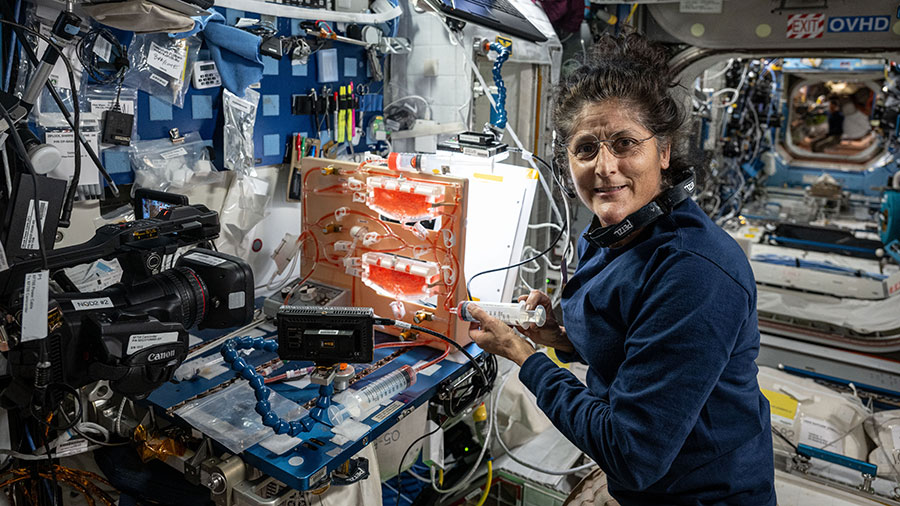
Thursday’s scientific objectives aboard the International Space Station included exploring ways to counter the effects of weightlessness on the human body and understanding how microgravity affects high-temperature physics. The two orbital crews also worked on research hardware, cargo transfers, household duties, and more throughout the workday.
Expedition 71 Flight Engineers Jeanette Epps and Matthew Dominick from NASA spent their shift together on Thursday testing a thigh cuff that may reverse the space-caused flow of body fluids toward an astronaut’s head. Dominick wore the thigh cuff that may change how fluids flow in the body as sensors recorded his physiological data. Epps scanned his veins with the Ultrasound 2 device, measured his blood pressure, and peered into Dominick’s eyes using standard medical imaging gear. Doctors on the ground remotely monitored the biomedical activities to determine the effectiveness of the thigh cuff. Results may counter the headward fluid shifts and prevent changes to eye structure and vision that may occur during long-term space missions.
Working in the Kibo laboratory module, NASA Flight Engineer Tracy C. Dyson stowed gear in Kibo’s logistics module to make space for an upcoming cargo delivery on the next Cygnus mission from Northrop Grumman. Afterward, Dyson cleaned the inside of Kibo’s Electrostatic Levitation Furnace and swapped samples inside the research facility that safely explores the thermophysical properties of materials exposed to temperatures as high as 2,000 degrees Celsius or more.
NASA Flight Engineer Mike Barratt focused mainly on household tasks throughout Thursday. He first replaced lithium-ion batteries in radiation detectors and lab hardware before swapping out orbital plumbing gear inside the Tranquility module.
NASA astronauts Butch Wilmore and Suni Williams of Boeing’s Crew Flight Test started their day servicing a variety of research hardware. Wilmore installed science gear inside the Microgravity Science Glovebox setting up a physics study that will observe how microparticles react to an electrical field. Williams disconnected cables and flash drives from a microscope ahead of troubleshooting activities. In the afternoon, the duo entered the Starliner spacecraft and conducted proficiency training inside the vehicle docked to the Harmony module’s forward port.
Station Commander Oleg Kononenko and Flight Engineer Nikolai Chub, both from Roscosmos, partnered together loading the Progress 87 resupply ship with trash and obsolete gear ahead if its departure planned for mid-August. Flight Engineer Alexander Grebenkin tested Roscosmos laptop computers and recharged their batteries.
Beginning Monday, July 29th, the IMC Daily Summary will be discontinued.
To learn more about the groundbreaking science and engineering happening daily on the International Space Station, please visit the space station blog at https://blogs.nasa.gov/spacestation/, or browse a variety of space station research resources at https://nasa.gov/iss-science.
Learn more about station activities by following the space station blog, @space_station and @ISS_Research on X, as well as the ISS Facebook and ISS Instagram accounts.
Get weekly video highlights at: https://roundupreads.jsc.nasa.gov/videoupdate/
Get the latest from NASA delivered every week. Subscribe here: www.nasa.gov/subscribe

